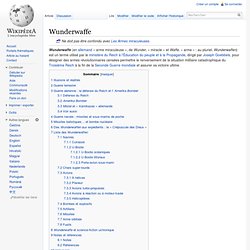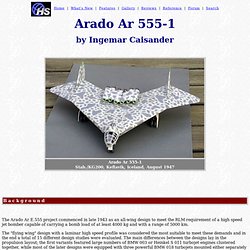

Wunderwaffe. Un article de Wikipédia, l'encyclopédie libre.

Wunderwaffe (en allemand « arme miraculeuse », de Wunder, « miracle » et Waffe, « arme » ; au pluriel, Wunderwaffen) est un terme utilisé par le ministère du Reich à l'Éducation du peuple et à la Propagande, dirigé par Joseph Goebbels, pour désigner des armes révolutionnaires censées permettre le renversement de la situation militaire catastrophique du Troisième Reich à la fin de la Seconde Guerre mondiale et assurer sa victoire ultime.
Illusions et réalités[modifier | modifier le code] La plupart de ces armes n'ont guère dépassé le stade de projet ou de prototype ou n'ont été utilisées que trop tard et en trop petites quantités par la Wehrmacht pour avoir eu un véritable impact sur les plans militaires et celui du déroulement des opérations. Mais si leur développement tardif n'a pas eu de réelle influence sur l'issue du conflit, ces armes ont suscité après la chute du Troisième Reich l'intérêt de plusieurs des pays vainqueurs. Arado E.555. The Arado E.555 was a bomber proposed by the German Arado company in response to the Amerika Bomber project.

Project request[edit] This was an initiative of the Reichsluftfahrtministerium (Germany Air Ministry), RLM, to obtain a long-range bomber for the Luftwaffe that would be capable of striking the continental United States from Germany. Requests for designs were made to the major German aircraft manufacturers early in World War II, long before the US had entered the war. Designs[edit] There were a several different configurations of the design considered, the most striking being the E.555-1.[1] This was a six-jet, angular flying wing design, with remotely-operated turrets, and capable of carrying a large payload.
Arado E.555 I Six engine[2] Messerschmitt P.08.01 - Ailes volantes ARADO - Arado Ar E.555. Arado E.555 par Ingemar Caisander (Revell 1/72) Arado Ar 555-1 by Ingemar Caisander The Arado Ar E.555 project commenced in late 1943 as an all-wing design to meet the RLM requirement of a high speed jet bomber capable of carrying a bomb load of at least 4000 kg and with a range of 5000 km.

The "flying wing" design with a laminar high speed profile was considered the most suitable to meet these demands and in the end a total of 15 different design studies were evaluated. The main differences between the designs lay in the propulsion layout; the first variants featured large numbers of BMW 003 or Heinkel S 011 turbojet engines clustered together, while most of the later designs were equipped with three powerful BMW 018 turbojets mounted either separately or together in different configurations. The Arado E.555-1 was to be constructed almost entirely of steel and Duralumin. The spacious internal belly bomb bay was capable of holding a bomb load of up to 4000 kg. Decals are provided for two (fictional) aircraft (of I. Back to Features Index. Prototypes.com/Les bombardiers à réaction d'Arado/X. Le bombardier stratégique Arado E 555-1.
Arado Ar E.555 série Luft '46 entrée. Arado Ar E.555 series In mid-December 1943, at the Arado facilities in Landeshut/Schlesien, work began on a flying wing project series under the direction of Dr.

-Ing. W. Laute. This was further elaborated by Dipl. . * with supplementary fuel tank.